
The Button 5.60 from General Dynamics Electric Boat. U.S. Special Operations Command
If We Were Really Going to Invade Iran, We Would Have Used This
The future of covert sea operations looks nothing like what just happened in Iran.
Yesterday, ten American sailors were detained by Iran after their boat came too close to Iranian territory. The Iranians wasted no time accusing the sailors of spying (before letting them go.) But if the U.S. military were going to send a small team into Iran on a covert mission, would they really use a patrol boat? Probably not.
In the future, the vehicle for that mission will look something like this: a claustrophobic torpedo-like, 30-foot mini-submarine capable of putting six to ten Navy SEALs on enemy shores.
Currently, U.S. Special Operations Command, or SOCOM, is testing a couple of different versions of a mini submarine for commandos: the 31-foot “Button” 5.60 by General Dynamics and Giunio Santi Engineering of Italy and the S351 by Submergence Group out of Connecticut and Britain’s MSUBS. (In October of last year, they successfully completed testing on a 23-foot test sub called the S301i by Lockheed Martin.) They’re piloted by humans and directed by sonar. The Button has a speed of 60 nautical miles at 5 knots. The picture above is of the technology demonstrator for the “Button.” The sub that the military ultimately deploys may look a bit different.
It’s not the first time that the Pentagon has experimented with mini-submarines for covert operators. In 1994, the military launched a program called to build six 65-foot submarines and two storage facilities at a projected cost of $524 million, with the first sub to be delivered in 1997. By 2003, the cost had grown to $2 billion before even one sub was delivered, according to a GAO report . In 2011, the military decided again to try and make dry mini-submarines, resulting in the current program.
The “Button” may seem unbearably uncomfortable but it presents an improvement over the Proteus , which is what’s called a “wet submersible.” It’s basically a submarine that isn’t sealed; the operators are submerged in water while they use it. Think of a dark, flooded coffin.
The water both inside and outside of the sub is sometimes very cold and the entire experience can wear on a SEAL, making it difficult to jump out in the dead of night and raid terrorist compounds.
“Sometimes with what we do, what we develop, it seems like the mission is to get someone from point A to point B when the real mission is to get someone from point A to point B to enable them to get to point C, D, E, and F and then back to point A,” Capt. Keith Lehnhardt, program executive officer for the dry submarine program, told Defense One last May. “The mission really starts when the SEALS get to the end, when there’s potentially bad guys shooting at them. Our job is to get them there as fresh as possible. If you’re sitting in the water column, just imagine that you’re sitting in cold water for hours breathing off a re-breather, not being able to talk to people next to you to precisely plan what’s next. Compare that to a dry environment where you can be comfortable, talk to each-other, do some last minute things that are necessary to the mission.”
So that’s what a covert SEAL mission looks like, not ten sailors lost on a patrol boat.




